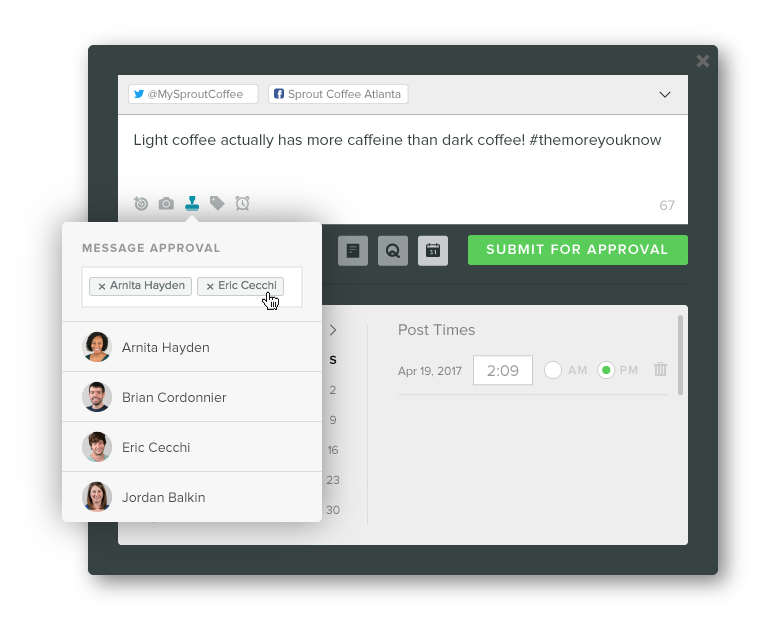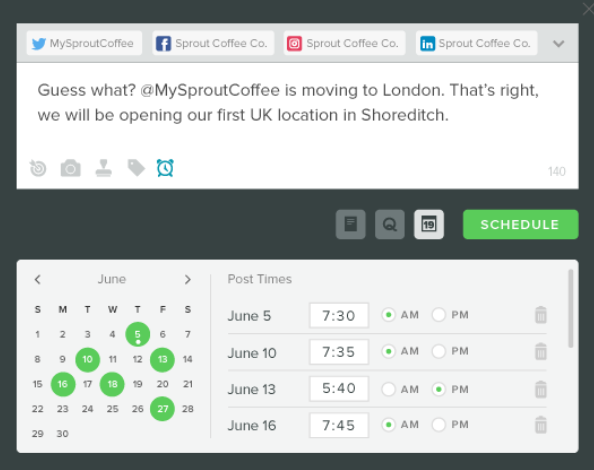Social media marketing requires a lot of careful planning and consideration.
When something as small as a single poorly-worded Tweet could be enough to land you in some serious trouble with your brand reputation, a solid social media approval process becomes a critical part of any marketing strategy. The problem is, it’s tough to maintain a consistent posting schedule on all your social channels when you’re constantly waiting for a thumbs-up from your approval team.
It can be a nightmare for both content creators and marketing strategists when managing the workflow of social content. Even with all the great social tools on the market, managing the approval process can be a challenge without the right plan.
There is good news–it doesn’t have to be that way.
There are plenty of moving parts to think about when putting together a social media approval process. Having the right process and tools in place could help to reduce the strain on your business in no time.
So, where do you get started?
Step 1: Define Your Approval Process
Before you start streamlining the social media approval process, you need to reach a decision on your business priorities before a post goes live. Ask yourself:
- Who will be responsible for creating content?
- Who’s responsible for approving that content?
- Who is going to make sure content goes out on time?
- What guidelines do you have for creators and approvers to follow?
- What happens if something slips through the cracks?
If you need to send social content to your boss every time it needs approval, it’s going to take a while to get things done. This means you’ll need to plan ahead to prevent them from becoming a bottleneck when you want to share content. The more you know about what your social media approval process involves, the better you’ll plan.
Keep in mind that 70% of agencies have their content approved around two weeks before posting.
An example of your content approval workflow might look something like this:
Content creator > Social media manager > Brand executive > Scheduling team
A Better Way to Manage Social
Request a Demo
A Better Way to Manage Social
Someone from our sales team will be in touch soon with more information or to schedule a private demonstration.
Thank You for Requesting a Demo!
Someone from our sales team will contact you shortly.

Step 2: Work out Deadlines
Once you know who will be involved in your social media approval process, start setting deadlines for each task. Keep in mind that your deadlines shouldn’t just include guides on Tweet times, but also:
- When each post, image, or video needs to be created
- How long proofreading should take
- When content should be delivered to executives or approval committees
Having social media publishing tools like Sprout Social makes it easier to post approved content to multiple networks according to stringent deadlines. The “Compose” window allows users to effectively schedule and distribute messages across a social media network, all from a single platform. There’s even a message approval solution integrated so people can be tagged to review and approve each post before it goes live.

Step 3: Train Employees on Content Expectations
If everyone on your social media creation, approval and publishing team knows their group’s expectations with each post, your publishing experience will go more smoothly.
By showing each team how to correct their own work as they create it and make decisions without guidance, companies empower social teams to get more done. The question is, how do you train your staff to save as much time as possible when it comes to approving valuable social content?
The easiest option is to create a style guide. An identity guide for your brand should include details on:
- Tone of voice: How do you talk to customers?
- Colors and visuals: What kind of imagery or logos do you use?
- Media share: When should creators use text, video, images or other content?
- Brand hashtags and mentions: How can you brand each campaign?
AirBnb regularly posts highly-engaging visuals across channels. But the main point is the colors, themes and hashtags match on each network. Their decisions obviously follow in-house guidelines for their brand.
This home in Tuscany is taking millennial pink to a whole new level. pic.twitter.com/4xA4UN0oTb
— Airbnb (@Airbnb) April 16, 2018
A post shared by Airbnb (@airbnb) on
Step 4: Train Teams to Spot Issues Early
While creating a style guide is a fantastic way to keep your social media team on point, there’s always a risk that something might slip through the cracks. This is particularly true when you’re bringing new content producers onto the team. With that in mind, make sure your approval team knows how to spot corrections early to make the process as quick and efficient as possible.
There’s no one-size-fits-all guide for what your content should look and sound like, but your approval team should probably look for the following issues:
- Controversial language: Some companies are more informal with their social posts than others. However, any controversial terms or phrases that might upset your followers need to be avoided at all costs. Consider adding must avoid terms to your style guide.
- Low-quality content: Photos that don’t match your existing Instagram theme, or videos that play poorly on Facebook could damage your reputation. Make sure that the content you publish highlights your brand image in a positive way.
- Poor optimization: Different social networks require content producers to follow different rules. Consider providing a checklist for each channel you use to keep teams on track.
- Mistakes: Are there any spelling or grammatical errors? A tool like Grammarly might help here.

Step 5: Use Tools to Support Your Team
One of the biggest problems companies have with social media approval processes is staying on top of all the work of a social strategy. For a very small team, a spreadsheet and weekly review might be enough to keep track of what’s created and what still needs to be approved in the social environment.
However, if your company has more than one social channel or profile, you need a more advanced option. Remember, the less time your team spends on the approval process, the more time they have to engage your audience, respond to key messages and create more great content.
A social advocacy tool like Bambu helps align on-brand messaging by providing a single interface approval system where teams can sort through the most appealing content for your brand messages. Additionally, it allows teams to curate pre-approved content for advocates to share, and access important company-wide information about guidelines, campaign context and more.

Step 6: Perform Post-Mortems on Your Post
Once a company has defined their content approval process, the hard work doesn’t stop. It’s crucial for companies to reevaluate their workflow on a regular basis to check for signs of problems or weakness. The more you examine your social media approval process, the easier it will be to see the roadblocks that might be damaging efficiency.
Not only should your approval process work efficiently, but you’ll also want to track and measure the performance of your social media posts to adapt your guidelines accordingly. The trouble is, the simple act of measuring your social performance can add more complexity to your social media marketing strategy.

After all, it takes time to develop a strong social media report that offers all the guidance you need to make informed decisions about your sharing practices. Once again, the right tools could be the answer here. For instance, Sprout provides presentation-ready reports on your social media performance, ranging all the way from weekly reports to monthly feedback.
Step 7: Automate Where You Can
Finally, once you’ve defined and created a social media approval process, it’s time to look for ways to further simplify the experience with automation tools. For instance, you shouldn’t have to send chat messages and emails notifying team members when your content is ready for approval. The faster you can get rid of these unnecessary time drains, the more effective your social strategy will be.
With Sprout, all you need to do is link the people on your team responsible for approving a post to the content and they’ll receive an update automatically. Remember, the more you can avoid getting high-level executives involved with the approval process, the better. The C-level of your team will likely be busy with a range of tasks each day. This means that they won’t always have the time to approve each Instagram post.
Consider choosing well-trained campaign leaders in your marketing team to oversee the approval process instead.

Simplifying Social Media Approval
Social media approval is an important part of making sure that you maintain the same brand voice and image on every channel you use to interact with your audience. Unfortunately, without the right strategy in place, this process can be time-consuming and complex. The good news is that the right tools and methodologies can make it easier for you to simplify approval for your team and speed up your social campaigns.
This post How to Streamline Your Agency’s Social Media Approval Process originally appeared on Sprout Social.
Powered by WPeMatico











